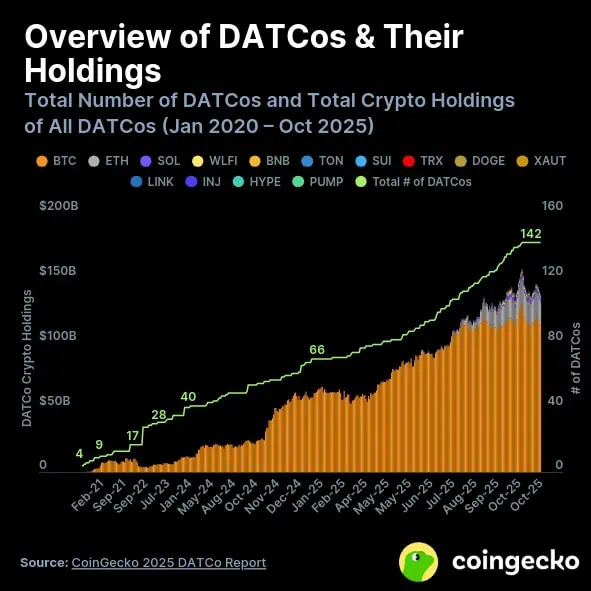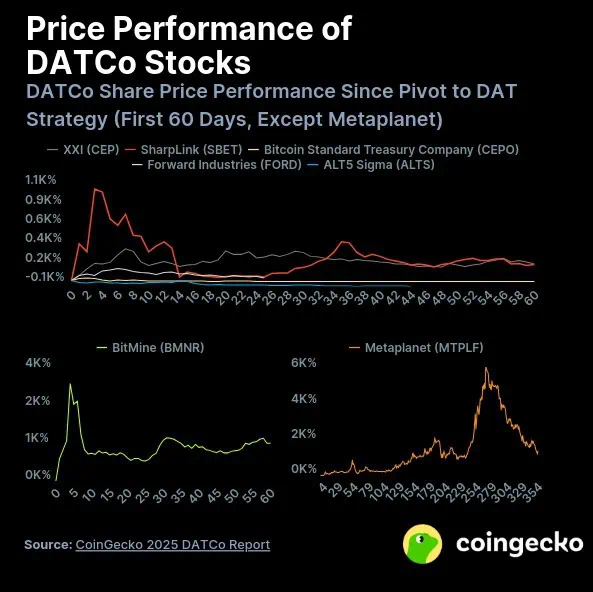
Corporate treasuries are moving away from Bitcoin and betting on alternative tokens, financing purchases with PIPEs and increasing the risk of volatility in the markets.
The standard championed by Michael Saylor, which for years defined corporate Bitcoin accumulation, has set a precedent that many companies are now adapting and extending to other cryptocurrencies.
The original strategy, based on buying and holding Bitcoin while accessing financing through debt backed by this digital asset, marked a key era in digital treasury management. However, by 2025, the landscape has evolved, and several public companies are exploring new avenues within the crypto ecosystem. diversifying their exposure to alternative tokens and adopting more aggressive financing models such as private equity.
According to experts, this change is occurring within a dynamic and rapidly transforming market context. While Bitcoin experienced a 13% correction in the last quarter, taking its price from $120.000 in mid-October to around $102.000 today, Companies are looking for new opportunities beyond the leading asset. The natural quest to maximize returns has led many to incorporate assets with higher risk profiles, contributing to greater volatility that links traditional markets and emerging cryptocurrencies more directly.
DATCos on the financial map: access crypto hereSaylor's strategy, far from becoming obsolete, has become a foundational model that serves as a starting point for innovation in management and diversification within the crypto world. The adoption of new forms of financing and the inclusion of alternative tokens reflect how the ecosystem is adapting to the changing needs and expectations of corporate investors, expanding the reach and sophistication of digital investments.
The rise of DATCos: what drives investments in crypto assets
The sector digital asset treasuries, known as DATCos, has undergone a significant transformation in the last year. According to a recent CoinGecko report, of the 142 DATCos registered at the end of October, 76 emerged during 2025 alone.These companies have invested approximately $42.700 billion in crypto assets, concentrating more than half of that investment in the third quarter of the year.
According to researchThis remarkable growth has been driven by two fundamental factors, beyond market price movements. First, a more favorable political context in the United Stateswhere the Trump administration has adopted an open stance toward cryptocurrencies, creating a more favorable regulatory environment for innovation and business experimentation. Secondly, a relevant accounting change endorsed by the new rules of the Financial Accounting Standards Board (FASB) by the end of 2023. These regulations allow companies to value their cryptocurrency holdings at market price and recognize unrealized gains as income, thus significantly strengthening their balance sheets through the appreciation of their asset value.
However, despite the growth of digital asset treasuries with alternative cryptocurrencies this year, the CoinGecko report also reveals that Strategy remains the dominant playerDATCos holds nearly half of all crypto assets, valued at close to $70.000 billion. Meanwhile, new entrants pursuing different paths accumulated approximately $22.600 billion in investments during the third quarter, with nearly half of that amount allocated to altcoins.
Bitcoin remains dominant. Buy BTC on Bit2MeOn the other hand, a Reuters analysis confirms the trend, showing that companies like Greenlane, OceanPal, and Tharimmune plan to expand their portfolios to include tokens like BERA, NEAR, and Canton Coin, which offer a different dynamic to the relative stability that Bitcoin represents.

Source: CoinGecko
The era of PIPE financing
These crypto treasury firms, many of which trade as penny stocks with limited cash flows, are funding their multi-billion dollar acquisitions through a less conventional method: private placements known as PIPE (private investment in public equity)In other words, instead of resorting to bank loans or using operating income, these DATCos sell large blocks of their own shares, usually at a discount, directly to private and institutional investors.
The Reuters report indicates that more than 40 of these companies raised more than $15.000 billion through PIPE agreements between April and November of this year. Interestingly, only five of those transactions were specifically for Bitcoin purchases; the majority of the capital went toward acquiring other tokens. According to experts, this model creates a cycle of dependency, as DATCos need their share price to rise to attract new funds via PIPE, and in turn, they use those funds to buy cryptocurrencies that they hope will boost their share value.
Surprisingly, major institutional investors are actively participating in this high-risk game. Names like Winklevoss Capital, Galaxy Digital, Jump Crypto, Pantera Capital and DWF Labs They have been identified in public data as buyers in these PIPE deals. For more cautious investors, DATCos offer a way to gain exposure to crypto returns through a regulated public company. However, this funding method comes at a cost: dilution for existing shareholders and extreme price volatility when the lock-up periods for those private shares end.
From Bitcoin to BERA: Trade crypto on Bit2MeThe risk is transferred to the stock market.
The emerging model of digital asset companies, or DATCos, is generating a highly volatile scenario, affecting both cryptocurrencies and the stocks of these companies. In their report, CoinGecko analysts highlighted a very defined speculative pattern: when a company announces its strategic pivot to the crypto sector, Their shares typically experience a significant increase in the first ten daysA striking example is BitMine Immersion, whose shares skyrocketed. 3.069% in that period.
However, this period of accelerated growth is usually short-lived, as subsequent corrections tend to be equally sharp. In the case of ALT5 Sigma, its shares fell 71% in the 44 days following its transformation into DATCo, and at the same time, its WLFI token assets also underperformed. This phenomenon, characterized by a mechanism of "pump and dump"This has caught the attention of regulatory bodies. In fact, CoinGecko notes significant price movements prior to the official announcement. have prompted investigations by the SEC and FINRA, in search of potential insider use cases.

Source: CoinGecko
Thus, the risk facing this sector is becoming increasingly tangible. Cristiano Ventricelli, vice president of digital assets at Moody's Ratings, explained to Reuters that the danger increases considerably as these companies expand their reach into less liquid and more complex cryptocurrencies. Furthermore, when markets show signs of decline, the pressure on these companies' financial resources intensifies.
Because they rely heavily on PIPE funding, their vulnerability to any weakness in the crypto market increases significantly. In this context, a potential collapse in cryptocurrency prices would not only affect token investors but could also have a severe impact on the shareholders of these publicly traded companies.
Trade altcoins: click and get started todayA shift in institutional crypto investment
The financial ecosystem is witnessing the creation of a new and complex investment vehicle. According to experts, second-generation DATCos are acting less as strategic cryptocurrency treasuries and more as extreme-risk hedge funds, but using the structure of a publicly traded company. attracting billions of institutional capital to place concentrated bets in the most illiquid corners of the crypto market.
Thus, while Strategy's Bitcoin model was based on the idea of a long-term store of value, these new structures aim for faster and more aggressive gains, often financed with dilutive capital. Experts warn that the line between traditional stock market investing and cryptocurrency speculation is blurring, reflecting an increasingly delicate boundary where these DATCos operate with great dynamism and complexity.

Main Cryptocurrencies Course
Basic levelBit2Me Academy brings you a new course in which you will learn everything you need about the most important cryptocurrencies that exist today.


